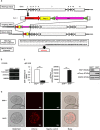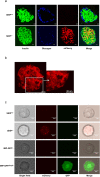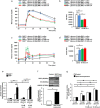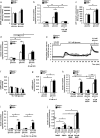Sphingosine kinase 1-interacting protein is a novel regulator of glucose-stimulated insulin secretion
- PMID: 28396589
- PMCID: PMC5429731
- DOI: 10.1038/s41598-017-00900-7
Sphingosine kinase 1-interacting protein is a novel regulator of glucose-stimulated insulin secretion
Abstract
Glucose-stimulated insulin secretion (GSIS) is essential in keeping blood glucose levels within normal range. GSIS is impaired in type 2 diabetes, and its recovery is crucial in treatment of the disease. We find here that sphingosine kinase 1-interacting protein (SKIP, also called Sphkap) is highly expressed in pancreatic β-cells but not in α-cells. Intraperitoneal glucose tolerance test showed that plasma glucose levels were decreased and insulin levels were increased in SKIP-/- mice compared to SKIP+/+ mice, but exendin-4-enhanced insulin secretion was masked. GSIS was amplified more in SKIP-/- but exendin-4-enhanced insulin secretion was masked compared to that in SKIP+/+ islets. The ATP and cAMP content were similarly increased in SKIP+/+ and SKIP-/- islets; depolarization-evoked, PKA and cAMP-mediated insulin secretion were not affected. Inhibition of PDE activity equally augmented GSIS in SKIP+/+ and SKIP-/- islets. These results indicate that SKIP modulates GSIS by a pathway distinct from that of cAMP-, PDE- and sphingosine kinase-dependent pathways.
Conflict of interest statement
The authors declare that they have no competing interests.
Figures






Similar articles
-
Durable islet effects on insulin secretion and protein kinase A expression following exendin-4 treatment of high-fat diet-fed mice.J Mol Endocrinol. 2008 Feb;40(2):93-100. doi: 10.1677/JME-07-0121. J Mol Endocrinol. 2008. PMID: 18234911
-
Metallothionein 1 negatively regulates glucose-stimulated insulin secretion and is differentially expressed in conditions of beta cell compensation and failure in mice and humans.Diabetologia. 2019 Dec;62(12):2273-2286. doi: 10.1007/s00125-019-05008-3. Epub 2019 Oct 17. Diabetologia. 2019. PMID: 31624901
-
The adaptor protein APPL2 controls glucose-stimulated insulin secretion via F-actin remodeling in pancreatic β-cells.Proc Natl Acad Sci U S A. 2020 Nov 10;117(45):28307-28315. doi: 10.1073/pnas.2016997117. Epub 2020 Oct 29. Proc Natl Acad Sci U S A. 2020. PMID: 33122440 Free PMC article.
-
Sphingosine kinase 1-interacting protein is a dual regulator of insulin and incretin secretion.FASEB J. 2019 May;33(5):6239-6253. doi: 10.1096/fj.201801783RR. Epub 2019 Feb 21. FASEB J. 2019. PMID: 30789757
-
Uncoupling protein 2 regulates daily rhythms of insulin secretion capacity in MIN6 cells and isolated islets from male mice.Mol Metab. 2017 Apr 27;6(7):760-769. doi: 10.1016/j.molmet.2017.04.008. eCollection 2017 Jul. Mol Metab. 2017. PMID: 28702331 Free PMC article.
Cited by
-
A prospective trial of abiraterone acetate plus prednisone in Black and White men with metastatic castrate-resistant prostate cancer.Cancer. 2021 Aug 15;127(16):2954-2965. doi: 10.1002/cncr.33589. Epub 2021 May 5. Cancer. 2021. PMID: 33951180 Free PMC article.
-
GLP-1R associates with VAPB and SPHKAP at ERMCSs to regulate β-cell mitochondrial remodelling and function.bioRxiv [Preprint]. 2025 Jul 20:2024.04.28.591531. doi: 10.1101/2024.04.28.591531. bioRxiv. 2025. PMID: 40791518 Free PMC article. Preprint.
-
Mitochondrial a Kinase Anchor Proteins in Cardiovascular Health and Disease: A Review Article on Behalf of the Working Group on Cellular and Molecular Biology of the Heart of the Italian Society of Cardiology.Int J Mol Sci. 2022 Jul 12;23(14):7691. doi: 10.3390/ijms23147691. Int J Mol Sci. 2022. PMID: 35887048 Free PMC article. Review.
-
Ceramide and Sphingosine 1-Phosphate in Liver Diseases.Mol Cells. 2020 May 31;43(5):419-430. doi: 10.14348/molcells.2020.0054. Mol Cells. 2020. PMID: 32392908 Free PMC article. Review.
References
Publication types
MeSH terms
Substances
LinkOut - more resources
Full Text Sources
Other Literature Sources
Medical
Molecular Biology Databases

